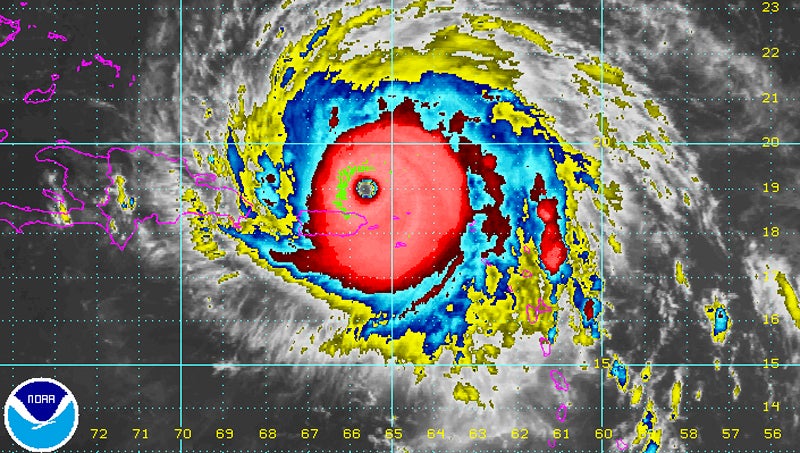Emergency Management urges residents to prep for Irma now
Published 7:13 pm Wednesday, September 6, 2017

- With hurricane season upon us, there are a number of simple steps families can take to ensure they are ready for the next storm. (NOAA)
As one of the strongest hurricanes the Atlantic Ocean has ever seen plows across the Caribbean Islands toward Florida, emergency management officials are quietly preparing for impact in Beaufort County.
“We’re expecting North Carolina to receive some type of impact from the storm,” said Carnie Hedgepeth, director of Beaufort County Emergency Management. “We wanted to go ahead and start communicating with the public that, ‘Hey, this has a real potential for impacting us where we are.’”
Wednesday, Hedgepeth and Beaufort County Emergency Services Director Chris Newkirk were establishing a 120-hour-out plan for Hurricane Irma, looking at many different scenarios for the county, from a little rain and light wind, to evacuations in advance of what could be a Category 3 hurricane, with sustained winds of 111-129 mph. At the time of print, Irma was a Category 5 hurricane with sustained wind speeds of 185 mph. The storm is expected to downgrade to a Category 4 over the next several days, according to the National Weather Service.
“The big thing is that there is still so much uncertainty as to what we can expect out of this storm. We want to make sure we’re ready for everything,” Hedgepeth said. “We know from past history our categories are 1 or 2 here, but this is not like normal storms we have in our ocean.”
Wednesday evening, Gov. Roy Cooper declared a state of emergency for North Carolina beginning 8 a.m. Thursday. Prior to that, county staff was checking in with long-term care facilities to make sure disaster and evacuation plans have been established, and determining potential availability of disaster response from Salvation Army and the National Guard — both are currently on the ground in southeastern Texas in response to the devastating flooding caused by Hurricane Harvey. Thursday, Hedgepeth brings all county department heads together to study the timeline of both the storm and county response. Keeping people informed is part of that response.
“Part of our plan in our office is addressing the possible range of impacts and preparing the public for what may come our way,” Newkirk said.
While Irma’s path is still unclear, Hedgepeth said now is the time to prepare. He said Beaufort County residents should be prepared to shelter in place for three days regardless of where Irma makes landfall, as even a significantly westward path could affect the power grid in eastern North Carolina.
“Even though we’re days out, we’d like people to take some kind of action,” Hedgepeth said.
“We like to set a benchmark of 72 hours, meaning we’re self-sustaining for 72 hours. We have enough food, water and supplies,” Newkirk said. “They should take the time now, while we’re in advance of this storm, to make sure they have all their insurance papers — have that accounted for and readily accessible. Have some cash on hand, because in the event of a power outage, you have to have it.”
Hedgepeth said residents should have two plans: a plan to shelter in place and a “ready bag” in case evacuation is necessary. Ready bags should contain clothing, toiletries, important papers, food and water, phones, chargers and first aid supplies, as well as any prescription medicines.
“Make sure you have enough to get through the days to come,” Newkirk said.
They recommended establishing a basic emergency supply kit, setting up evacuation plans for both people and pets and determining how to communicate those plans to others.
“Regardless of what their action is, they need to have some type of path of communication for their family members, to let them know, ‘I’m leaving my house and going to this location,’” Newkirk said.
Hedgepeth said it appeared eastern North Carolina could feel Irma’s presence as soon as Monday, but cautioned residents not to be fooled by the temperate weather until then.
“The best advice we can give is: stay informed, continue to monitor the weather, stay in touch with local officials and what they’re giving out, and begin those preparations now,” Newkirk said. “With events like this, the future is so uncertain, it puts us in a position where we plan for the worst, but hope for the best.”
“Actually, we pray for the best,” Hedgepeth said.
FEMA Basic Emergency Supply Kit
- Water, 1 gallon of water per person per day for at least three days (for drinking and sanitation)
- Food, at least a three-day supply of non-perishable food
- Battery-powered or hand crank radio and a NOAA Weather Radio with tone alert and extra batteries for both
- Flashlight and extra batteries
- First aid kit
- Whistle to signal for help
- Dust mask, to help filter air, and plastic sheeting and duct tape to shelter-in-place
- Moist towelettes, garbage bags and plastic ties for personal sanitation
- Wrench or pliers to turn off utilities
- Can opener for food
- Local maps
Communication
- Charged cellphones
- Hyper-Reach: Beaufort County Emergency Management program that reports, via text, phone call and/or email, all real-time notices affecting registered users, including road closures, power outages, watches and warnings, curfews, mandatory evacuations and more. Landlines are automatically registered with the system. If a cellphone is the primary phone, the number must be registered through the Hyper-Reach website. The registration form can be found by going to the county’s website, www.co.beaufort.nc.us, scrolling to the bottom of the homepage and clicking on the red Hyper-Reach button on the right.
- ReadyNC app for smartphones: this free app reports local weather, road conditions, power outages, shelter openings, evacuations and more.





